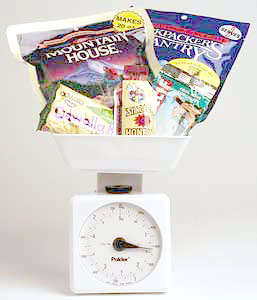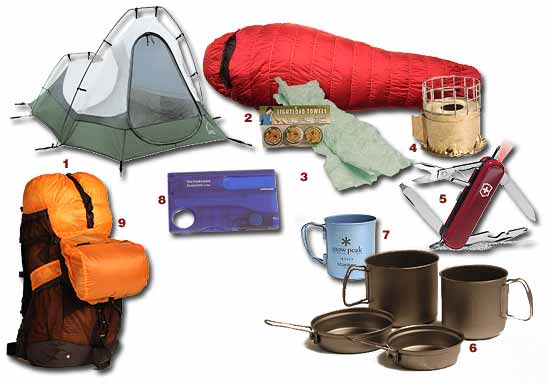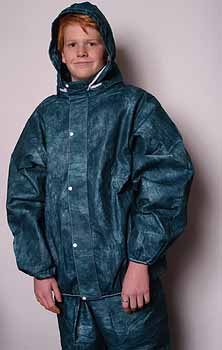Lighten Up!
- Join the Discussion
- Outdoor Smarts in previous issues
By Karen Berger
Photographs by John R. Fulton Jr.
Don't let a heavy backpack weigh you down. Learn how to reduce gear and trim ounces without sacrificing safety or comfort.

There is a new breed of hiker on the nation's backpacking trails. You may have seen one of them pass nimbly by as you trudge forward beneath the weight of your 40-pound pack.
So what do these light-on-their-feet hikers know that you don't? Basically, it's how to strip excess weight from their load without risking safety or forfeiting much comfort.
Know the numbers
There's no doubt that a lighter pack makes a hike more enjoyable. When you're toting 30 pounds instead of 40 or 50, miles pass more easily, aches and pains are fewer, and mountains seem smaller.
The advantages are especially important for Scout-age boys, who can't carry as much weight as adults. But heavy loads also take their toll on adults, whose knees and legs begin to show wear and tear from years of hard use.
Before you replace a piece of camping gear, weigh it (a small kitchen scale measures pounds and ounces). Never replace an item with something heavier. If you're just starting to buy gear, check out the weight of each item and compare it to others on the market.
Choose the lightest item that will function in the conditions you expect to encounter. For example, two-person tents range from less than four pounds to more than eight pounds. And don't forget the backpack itself, which can range from one to seven pounds.
Of course, safety comes first when choosing camping gear; a lighter pack is a bonus only if it contains what you need to be safe.
And don't neglect comfort. Will the benefits of a lighter pack be worth not having a warm-enough sleeping bag or dry clothing layers to wear in camp?
Know what you need
No single item can meet the needs of all hikers in all conditions. A 10-pound winter tent is not only too heavy for summer but may even be less comfortable in warm weather than a one-pound tarp.
On the other hand, extra-light gear designed for temperate climates may not be appropriate for high mountains and sudden storms.
Keep a list of gear you take on hikes and mark what you use and what you don't. Genuine emergency items, such as "The 10 Essentials" (see Outdoor Smarts, March-April 2004), should remain in your pack, whether you use them or not. Everything else is up for negotiation.
Most hikers can lose a pound or two by cutting back on extra clothes and replacing heavyweight cotton items with lighter nylon or polyester. Use caution, however. Carry enough warm clothing for unexpected weather or an emergency. You can also cut weight by measuring out small amounts of first-aid supplies, spices, and other everyday items.
Skip 'bells and whistles'
Some gear has extra features, such as zippers, pockets, pouches, pull strings, draw cords, and leather patches, which add extra weight but are rarely essential.
 Examples of lightweight gear: (1) Sierra Designs Clip Flashlight tent; (2) GoLite's Doze down sleeping bag; (3) Lightload Towels, 1/2 ounce each, www.ultralighttowels.com; (4) Brasslite alcohol stove; (5) Victorinox Midnite Manager includes ballpoint pen and light; (6) Snow Peak's four-piece titanium Trek Combo weighs 13 ounces and (7) its titanium mug, 2.4 ounces; (8) Victorinox SwissCard Lite includes 13 tools in a credit card-sized holder; (9) GoLite's Race pack weighs 1 pound 9 ounces. |
For example, an average waterproof, breathable rain jacket weighs about a pound. A minimalist version, such as a Frogg Toggs jacket, tips the scale at a mere nine ounces.
True, for hiking above timberline in September, you'll want a heavier jacket with extra features. But for a summer rainstorm on the Appalachian Trail, the lighter jacket may do the job at about half the weight.
Know the manufacturers
Most traditional camping gear weighs in at the middle to heavy end of the scale. This is because many products are loaded with extra features and are made with rugged materials for durability.
When choosing gear from major manufacturers, look at their lightest offerings first. Check out the following product lines: Kelty packs, Marmot sleeping bags, Feathered Friends sleeping bags, Osprey Packs, and Sierra Designs tents.
In addition, GoLite, a specialist lightweight manufacturer, offers a wide variety of rugged products at reasonable prices. The GoLite catalog gives you examples of how little gear can weigh.
Cooking and eating
Food and cooking gear can be among the heaviest items in your pack. Cut weight by taking only what you need. Leave nesting pans, spice containers, and numerous single-purpose utensils at home.
In fact, a light pot (titanium or aluminum), a Lexan spoon, and a small cup are all you really need.
Pre-measure and weigh all food items. A daily ration should total no more than two pounds; many hikers can manage fine with 1 1/2 pounds or less.
Pack high-energy foods, such as peanut butter, cheese, dried sausage, and energy bars. For breakfast, a dense, calorie-loaded cereal is best. Dinners should feature mostly dried ingredients, such as rice or pasta, mixed with vegetables, sauces, gravies, or cheese.
Freeze-dried foods are conveniently packaged and usually (but not always) weigh less than the same store-bought ingredients.
Other favorites are instant soups or Ramen noodles. The just-add-water soups and stews available at health-food stores give excellent weight-to-calorie value. You can also dehydrate meals after cooking them at home.
 Frogg Toggs, www.froggtoggs.com, are lightweight, waterproof, and breathable. |
Double up and miniaturize
Look for gear that can be used for more than one job. For example, trekking poles can be tarp supports. Extra clothing layers are great for a neck warmer or as stuffing for a pillow.
Check out new miniature equipment. Some Swiss army knives are now about the size of a pen cap and LED flashlights are the size of a quarter. Miniature towels fold to the size of an Oreo cookie.
Experiment
Don't be afraid to experiment, especially on shorter hikes in good weather.
On dry, well-maintained trails, for example, some hikers find trekking shoes or sandals as comfortable as hiking boots. A tarp may offer adequate shelter at a fraction of the weight of a tent, and you can save a pound by sleeping on a closed-cell foam pad rather than an air mattress.
Other inventive strategies include sleeping in hammocks, cooking on compact alcohol-fueled stoves, or even making your own gear.
Karen Berger's latest book is the Hiking Light Handbook: Carry Less, Enjoy More (Mountaineers Books, 2004). For more lightweight tips, visit her at www.hikerwriter.com.
Join the DiscussionOnline forums are great for getting ideas from other lightweight camping enthusiasts. Two places to start are www.backpacking.net and www.backpackinglight.com. In particular, you can learn about the innovative weight-saving products offered by smaller companies that do business mainly on the Internet. For example, check out the elegant simplicity of Brasslite's alcohol-burning stove (www.brasslite.com) or the innovative features of Moonbow's (www.moonbowgear.com) custom-made pack, which unfolds to become a ground cloth, tent, and dining awning—at a total weight of less than 10 pounds. — K.B. |
September 2004 Table of Contents
Copyright © 2004 by the Boy Scouts of America. All rights thereunder reserved; anything appearing in Scouting magazine or on its Web site may not be reprinted either wholly or in part without written permission. Because of freedom given authors, opinions may not reflect official concurrence.